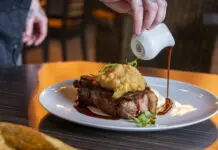The Annual Trend Forecast
In the words of Heidi Klum circa 2005: “You’re either in, or you’re out.” While she may have been talking about reality TV show contestants, the saying also works well for wedding trends. After all, something you may have on Pinterest just last year may already be démodé in 2025. But worry not – we’ve compiled a trend forecast for this year and beyond so you’ll be able to stay on top of what’s “hot.” (Also, as I say every year, do what you want – it’s your day.)
Destination weddings – Many couples are nixing major celebrations in lieu of a destination wedding with close friends and family, often choosing a meaningful location for their ceremonies.
More personalized experiences – While many wedding traditions are great and in place for a reason, some pairs are eschewing expectations by personalized their wedding with private last dances or vow readings, multi-day events or experiential vendors.
Sustainability – If you aren’t thinking about sustainable efforts in the year 2025, it’s time to pivot. Even small changes, like using locally sourced food or biodegradable decor, will make a big difference.
Interactive food stations – We know what you’re thinking: Do you mean a buffet? Kinda, but couples today are adding more elements to their food bars to personalize the experience for dinners, whether the main dish is tacos, burgers, pasta, pizza or something in between.
Dramatic décor – While subtle, quiet luxury will always be in style, brides and grooms are going dramatic this year with floor-to-ceiling decor and lush floral installations.
Outfit changes – For the fashion-forward couples, outfit changes after the ceremony are a popular way to keep the evening dynamic and ever-interesting.
Film-style photography – Nostalgia is in; you’ll likely see a lot more film photography in the coming year.
Wedding Budgeting 101
Sooo, we’re not sure if you know this, but weddings can be expensive. If you don’t have an endless flow of cash, then staying on budget should be a main priority. We offer a few suggestions to get you started.
Set a Realistic Budget – And when we say realistic, we mean it. You shouldn’t be going deep into debt for your wedding. Determine your financial limits and create hard budgets that outline exactly where your wiggle room ends. If you have family or friends that are contributing, get the hard numbers from them, too.
Tally Up Your Costs – While the major wedding costs, like the venue, food, flowers and honeymoon are obvious parts of your list, don’t forget to budget in the random venue fees, rentals, tips/gratuities, insurance and employee overtime charges.
Identify Your Priorities – Aside from marrying the love of your life, what are the main priorities for your wedding day? Do you want a visually stunning day? For your guests to have the time of their lives? To eat and drink without a worry in the world? Once you know your top priorities, it will make it easier to cut down on the other facets to save money.
DIY (Selectively) – Unless you are the craftiest person in the world, DIY projects should be limited for your wedding, but can still be helpful in saving money. Things like signage, centerpieces, garlands or memory walls are great places to start.
Trim Your Guest List or Bridal Party – Smaller weddings have smaller budgets, so don’t be afraid to cut down on your number of guests. As for your bridal party, you’ll save money by slimming it down or eliminating it all together; just make sure your friends still feel valued!
Be Smart About Your Flowers – A little bit of research goes a long way in determining what kind of flowers you should have at your wedding if you’re aiming to save money. Just ensure the blooms you want are in season and you’ll already be ahead of the game.
Stay Organized – If you have all your important documents, contracts, deadlines, payments and other information stored in a smart way, you’re more likely to get all orders and payments in on time, saving you money down the road.

A Dress Code Breakdown
Dress codes have been, for decades and maybe even centuries, a real stressor for guests. After all, the last thing you want to do is show up over- or underdressed – or even, gasp, off-theme – to a friend or family member’s big day. That said, let’s explore some common ‘dress codes’ and what you should wear.
White-Tie: If you’re invited to a white-tie occasion, you should don the most formal wedding attire possible. Women should be in floor-length gowns, and men should be in tuxedos with tails. Footwear should be elegant heels for women and Oxfords or other high-quality dress shoes for men.
Black-Tie: A step down from white-tie, black-tie events require similar outfits (gowns and tuxedos) without the staunch limitations on footwear and accessories.
Formal or Black-Tie Optional: Undoing those restrictions a bit more, formal/black-tie optional allows women to raise the hems of their dresses – meaning a floor-length gown isn’t necessary, or opt for an elevated pant suit. Men can wear tuxedos, or go for a formal suit in a darker color.
Cocktail: Perhaps the most common dress code for weddings, cocktail attire frees things up for the women, allowing tea-, knee- or midi-length dresses, while men need to stay in suits and ties – although they don’t have to be dark or wholly neutral colors.
Festive: Typically, ‘festive’ translates to cocktail attire with flair. This means taking a few fashion risks – incorporating fun patterns, bold colors and unique silhouettes.
Tropical or Destination: This dress code implies the wedding will likely be outdoors in the heat, so consider tropical or floral patterns, lightweight fabrics and airy silhouettes. Don’t forget sunscreen, sunglasses and a sun hat!
Themed: In short, you’ll need to dress in accordance with the theme of the wedding for this one. Some people opt for a specific color scheme – like all-white or shades of green, while others include a concept – like Western, disco, or The Great Gatsby. Ideally, the couple will offer an inspiration board to help you get started.
Global Wedding Traditions
We’ve got the bouquet toss, giving away the bride, speeches and toasts – but other wedding traditions exist outside our bubble. We take a look at traditions you’ll find at weddings here in the U.S. and across the world.
• Breaking of Glass – Found at Jewish weddings, glass is typically broken/stepped on at the end of the wedding ceremony to symbolize the fragility of life and the start of a new marriage.
• Jumping the Broom – Mostly popular with American and Canadian Black couples, jumping the broom symbolizes a fresh start or the sweeping away of the past and a full commitment to the future as a couple.
• Cutting of the Log – A tradition most often found in Germany, the cutting of the log sees the bride and groom working together to saw a log in half – their first challenge to overcome as a married couple.
• The Blackening – A northeastern Scottish tradition, the Blackening occurs when friends and family throw various substances – like syrup, flour, eggs and mud – on the couple before their big day for good luck.
• The Joota Chupai – An Indian tradition, the joota chupai entails the bride’s family trying to steal the groom’s shoes, with the groom’s family trying to protect them. A ‘ransom’ is often paid if the bride’s family wins, and the ritual is meant to help the combining families bond.
• Sake-Drinking Ceremony – Typically found in Japan, the sake-drinking ceremony welcomes the couple and their parents to sip sake three times from different sized cups, symbolizing the unity of their two families.
Your Registry: How to Perfect It
Whether you already live with your partner or are just now combining homes, creating a fine-tuned registry is key to starting off your lives together on the right foot. A registry, in essence, should mix practical items with luxurious gifts you wouldn’t typically splurge on yourselves. We offer just a few suggestions:
Kitchen Essentials: Whether you cook every night, a couple of times a week or just once a month, having quality cookware, like high-grade knives and cast-iron skillets, is a must. Consider the appliances you don’t yet possess, whether those are food processors or air fryers, as well as glassware and dinnerware you’ve been eyeing. Drinkers can include bar accessories, like decanters or fancy highball glasses, and you can always ask for high-end cutting boards and serving trays if you feel you’ve got the majority of your kitchen under control.
Bedding and Linens: Many couples won’t splurge on luxurious comforters, pillows and sheets, which is why it’s a great idea to put items like that on your registry. Make sure to include nice bath and hand towels, as well.
Cash Funds: While many considered asking for money as opposed to gifts as gauche until the last decade or so, it’s a fairly common practice to request cash funds for specific occasions – whether that’s for the honeymoon, home improvements or a down payment on a house. You can also request gift card donations for specific stores if you’d rather pick out items yourselves.
Home Goods: If you’ve wanted to make your house a home but haven’t had the time or budget, the wedding registry can help. Consider home decor options, like photo frames, art or vases, as well as storage baskets and bins to keep things organized. Some couples even add furniture, like chairs, coffee tables or entertainment consoles to their registry.
Other rules of thumb for your registry:
– Focus on items you’ll actually use.
– Mix the practical and the fun.
– Don’t avoid expensive gifts. People can pool their funds for a larger item.
– Consider where you live and your storage capacities when choosing your items.
– Keep your registry updated to avoid repeat gifts.





















